
Sabine Baring-Gould of Lew Trenchard in Devon, England, was an Anglican priest, hagiographer, antiquarian, novelist, folk song collector and eclectic scholar. His bibliography consists of more than 1,240 publications, though this list continues to grow. His family home, the manor house of Lew Trenchard, near Okehampton, Devon, has been preserved as he had it rebuilt and is now a hotel. He is remembered particularly as a writer of hymns, the best-known being "Onward, Christian Soldiers", "Sing Lullaby", and "Now the Day Is Over". He also translated the carol "Gabriel's Message" from the Basque language to English.

Arlington was a manor, and is a village and civil parish in the North Devon district of Devon in England. The parish includes the villages of Arlington and Arlington Beccott. The population of the parish is 98.

Trerice is an historic manor in the parish of Newlyn East, near Newquay, Cornwall, United Kingdom. The surviving Tudor manor house known as Trerice House is located at Kestle Mill, three miles east of Newquay. The house with its surrounding garden has been owned by the National Trust since 1953 and is open to the public. The house is a Grade I listed building. The two stone lions on the front lawn are separately listed, Grade II. The garden features an orchard with old varieties of fruit trees.

Germoe is a village and civil parish in Cornwall, England, United Kingdom. Germoe village, the parish's main settlement and church town, is about five miles (8 km) west of Helston and seven miles (11.3 km) east of Penzance. The A394 Penzance to Helston road runs along the southern border of the parish. Other settlements in the parish include Balwest, Boscreege and Tresowes Green.

Filleigh is a small village, civil parish and former manor in North Devon, on the southern edge of Exmoor, 3.5 miles (5.6 km) west of South Molton. The village centre's street was, until the 1980s opening of the North Devon Link Road, the main highway between the North Devon administrative centre of Barnstaple and South Molton, leading westwards to Taunton. Much of the village's land is contained within grade I listed park and garden, Castle Hill, which straddles both sides of the Link Road providing a glimpse of some of it.

Tawstock is a village, civil parish and former manor in North Devon in the English county of Devon, England. The parish is surrounded clockwise from the north by the parishes of Barnstaple, Bishop's Tawton, Atherington, Yarnscombe, Horwood, Lovacott and Newton Tracey and Fremington. In 2001 it had a population of 2,093. The estimated population in June 2019 was 2,372.

Mamhead is a rural village and civil parish near Dawlish and Kenton in Devon, South West England, in the Teignbridge local authority area. Current community venues include Mamhead Village Hall and The Church of England parish church, dedicated to St Thomas the Apostle,
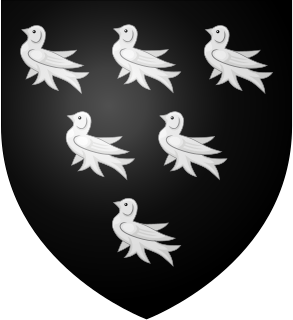
John Arundell, Esquire, of Trerice in Cornwall, later given the epithet "Jack for the King", was a member of an ancient Cornish gentry family, who as a Royalist during the Civil War served King Charles I as Governor of Pendennis Castle, Falmouth, which in 1646 he retained in a heroic manner during a five-month long siege by Fairfax, during which his forces were reduced by hunger to eating their horses, and finally received an honourable surrender. He served twice as MP for the prestigious county seat of Cornwall, and for his family's pocket boroughs of Tregony (1628) and Mitchell (1597) and also for St Mawes (1624). His family "of Trerice" should not be confused with the contemporary ancient and even more prominent Cornish family of Arundell "of Lanherne", six miles north of Trerice, "The Great Arundells", with which no certain shared origin has been found, but which shared the same armorials, the Arundell swallows.
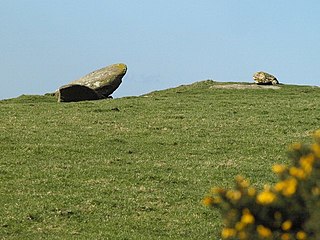
Hendraburnick is a farmstead near Davidstow, Cornwall, England. On Hendraburnick Down is the source of the River Camel.

Roborough is a village and civil parish 5.5 mi (8.9 km) from Great Torrington. Situated topographically on the plateau between the Torridge and Taw Rivers, the parish covers 1,258 ha and contains a population of some 258 parishioners. It is surrounded by a pastoral landscape of rectangular fields, high hedges and scattered farmsteads.

Sir Hugh Courtenayof Boconnoc, Cornwall, was MP for Cornwall in 1446-47 and 1449-50. He was beheaded after the Battle of Tewkesbury in 1471.

Luffincott is a civil parish in the far west of Devon, England. It forms part of the local government district of Torridge and lies about six miles south of the town of Holsworthy. The parish is surrounded clockwise from the north by the parishes of Tetcott, Ashwater, St Giles on the Heath and Northcott. Its western border follows the River Tamar which forms the county boundary with Cornwall.
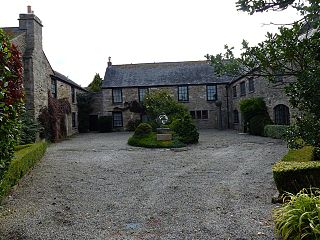
Arwenack, historically in the parish of St Budock, Cornwall, is a historic manor on the site of what is today the town of Falmouth. It was partly destroyed in 1646, and only a remnant survives today. It was long held by the Killigrew family, which was responsible for the development of the town of Falmouth, Sir Peter Killigrew, MP, having received a royal charter for its foundation in 1661.
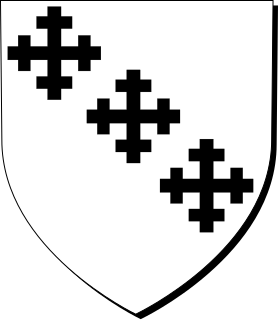
Sir Henry Northcote, 4th Baronet (1655–1730) was an English baronet from Devon. He was by profession a doctor of medicine. His great-great-great-grandson was Stafford Northcote, 1st Earl of Iddesleigh (1818–1887).
The Feudal barony of Cardinham is one of the three feudal baronies in Cornwall which existed during the medieval era. Its caput was at Cardinham Castle, Cornwall. The Barony was held in recent times by the Vivian family, the last being Nicholas Vivian, 6th Baron Vivian. Brigadier Nicholas Crespigny Laurence Vivian, 6th Baron Vivian, conveyed the title to John Anthony Vincent of Edifici Maxim's, Carrer General, Arsinal, Principat Andora, in 1995. Mr. Vincent was a member of the Manorial Society of Great Britain and died in Douglas, Isle of Man, on 31 March 2018. The Barony was then conveyed after the probate of his estate to an American citizen on 25 May 2019.
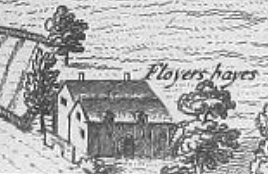
Floyer Hayes was an historic manor in the parish of St Thomas on the southern side of the City of Exeter in Devon, England, from which city it is separated by the River Exe. It took its name from the ancient family of Floyer which held it until the early 17th century, when it was sold to the Gould family. In the 19th century the estate was divided up and the manor house demolished. The parish church of St Thomas, situated a short distance to the west of the house, was burned down in 1645 during the Civil War, and was rebuilt before 1657. Thus no monuments survive there of early lords of the manor, namely the Floyer family.
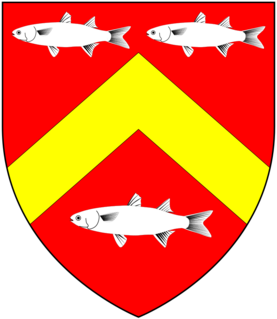
John Militon of Pengersick Castle in the parish of Breage in Cornwall, was Governor of Saint Michael's Mount, Cornwall, in 1547.

North Wyke is an historic manor in the parish of South Tawton, Devon. The surviving grade I listed manor house, the original Devonshire seat of the Wyke family from the early 13th century to 1714, retains its basic mediaeval form, but was "improved and reconstructed" by Rev. William Wykes-Finch (d.1920) in 1904, historian and descendant of the Wyke family, to the design of G.H. Fellowes Prynne. Currently, the manor is part of Rothamsted Research's North Wyke site.
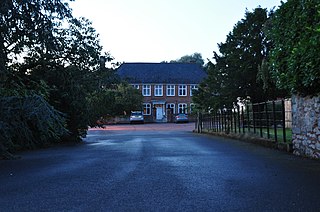
Ford's Moore is an historic estate in the parish of Plymtree in Devon. From before 1161 to 1702 it was the seat of the at Ford family, whose coat of arms is recorded in the heraldic visitation of Devon as Gules, a castle argent crowned or on the port a cross formée of the third. The present farmhouse is a grade II* listed building which remains largely unaltered since it was built in the late 17th century as the mansion-house of the Ford family, when it was one of the earliest brick-built houses in Devon. The interior contains much original decorative plasterwork and carpentry, including a dogleg staircase. A much worn ledger stone survives on the floor of Plymtree Church inscribed: Roger Forde, Esquire, was here buried July the 21st An Do 1631, with another to Thomazin Ford (d.1690) inscribed: Here lyeth the Body of Thomazin Ford, wife of Charles Ford of Plymtree, Esq., and Daughter of Abraham Webber, Gent., who departed This life the xxth day of September in The yeare of Anno Do. 1690, aged 69 yeares. Ann Ford, a co-heiress of Ford's Moore, married William Chave, and purchased or otherwise obtained all the outstanding shares in the property. She bequeathed it to her cousin William Wright of Collumpton, from whom it descended to his niece the wife of Charles Phillpott, the owner in 1822, a banker from Bath in Somerset, commissioned into the Freemasons of Bath in 1784. In 1850 the owner was A. Philpott, Esquire.

Hugh Fortescue, 1st Earl Clinton, 14th Baron Clinton of Castle Hill in the parish of Filleigh, and of Weare Giffard Hall, both in North Devon, and of Ebrington Manor in Gloucestershire, was a landowner and peer. He built the surviving Palladian stately home of Castle Hill.




















